
Credit: Malte Mueller/Getty
Career mobility: Researchers change places to progress
Moving countries to further a career in science has its benefits, but it isn’t an option for everyone.
1 April 2019
Mobility brings many rewards in science. But what do scientists make of the growing pressure to be internationally mobile? We profile five researchers with diverse perspectives.
They are all proponents of movement, in spite of the personal and professional costs, but acknowledge that for many of their colleagues it may not be an option. Jonah Choiniere, a palaeontologist from the United States who currently lives in South Africa, says the global push for mobility could widen the disparity between the haves and have-nots.
Mobility in the index
In a recent paper, Rodrigo Costas at Leiden University in the Netherlands, along with a team of researchers in Spain, the US and Canada, described a method for tracking the movements of scientists based on their article affiliations. Costas applied this method to the subset of researchers that published research papers in the 82 high-quality journals included in the Nature Index in 2017.
The analysis assessed the 10-year publication record of some 324,000 researchers, 66% of whom published their first paper during this period. More than three-quarters of the researchers were not internationally mobile between 2008 and 2017, meaning that they had only one country of affiliation. Another 16% had two countries of affiliation — some had transitioned from one country to the other, categorized as migrants, while others had retained their links with more than one country, identified as travellers. A small percentage of researchers (1.3%) were affiliated with an astounding five or more countries.
Of the migrants, the largest majority were researchers who had moved to China from the US, though it is not clear whether the journey represented a return home. A comparatively large number have made the reverse trip from China to the US, and from Germany to the US.
The five researchers profiled below were selected by analysing researcher mobility in the Nature Index, to reflect the diversity of migration, from those who have stayed close to home, to distant travellers and science nomads. South Africa is notable for accepting more science migrants than it sends abroad: two scientists who have moved there to work are profiled here.
JONAH CHOINIERE: Dinosaur scout
Migrant
A US palaeontologist in South Africa challenges the inequities of mobility.
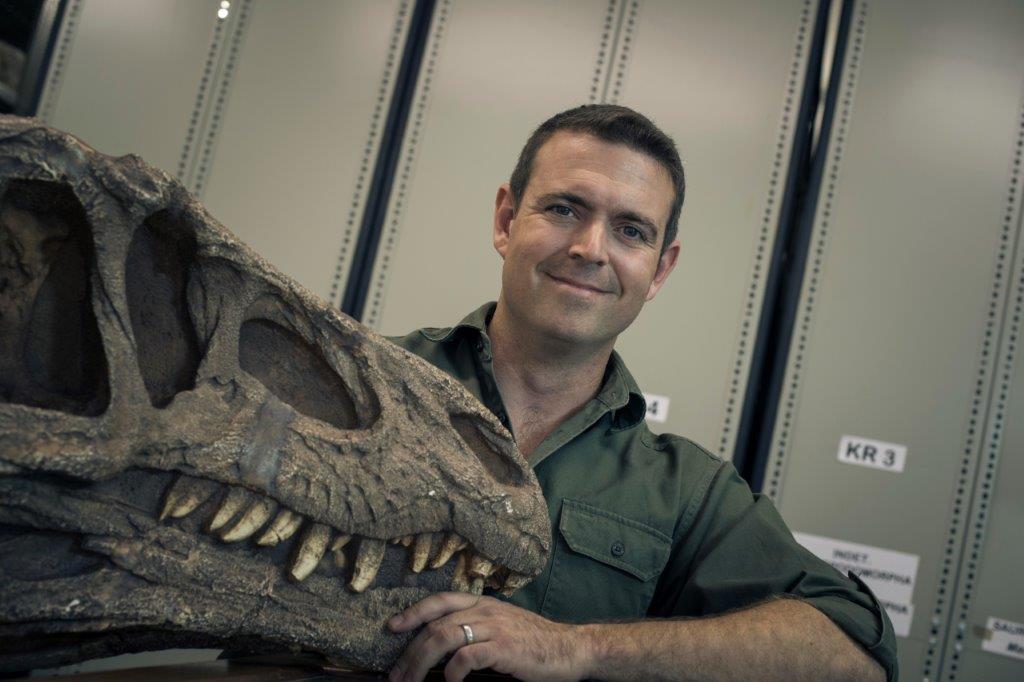
Brett Eloff
Jonah Choiniere has searched the Earth for dinosaur fossils, and settled on a circle of mud and silt along the border between Lesotho and South Africa. The palaeontologist at the University of Witwatersrand, Johannesburg, spends up to 10 weeks a year digging for dinosaur remains across the vast terrain.
Travel is a joy and a prerequisite of the job, says Choiniere. But it is also a privilege that few in the region can afford. “The price of mobility excludes many African scientists from participating in scientific exchange,” he says.
Originally from Massachusetts, Choiniere has visited museums and sites of dinosaur deposits all over the world, from China to Argentina, Spain, Germany and the United Kingdom. As a postdoctoral fellow at the American Museum of Natural History, in New York, he spent entire summers driving across the sandstone cliffs of Mongolia’s Gobi Desert looking for traces of extinct lizards.
Field excursions, conference visits and museum trips are invaluable opportunities to network, develop new research skills and approach questions from untested angles, says Choiniere. “Meeting with foreign students during my PhD opened my eyes to the vast number of things I could do with my data,” he says. “Face-to-face interactions provide the kind of exposure that no amount of reading someone’s resume can get across.”
It was during one of these trips that he first learned of the vast fossil resources in South Africa, returning in 2013 to take up a permanent position at Witwatersrand. Choiniere describes his time in the country as “the best research years of my career”. He enjoys academic freedom, a good work–life and research–teaching balance, and long-term job security. “I could easily be entering my early 40s doing postdocs in the US; instead, here, I will be a full professor by the end of this year,” he says.
Giant thunderclap
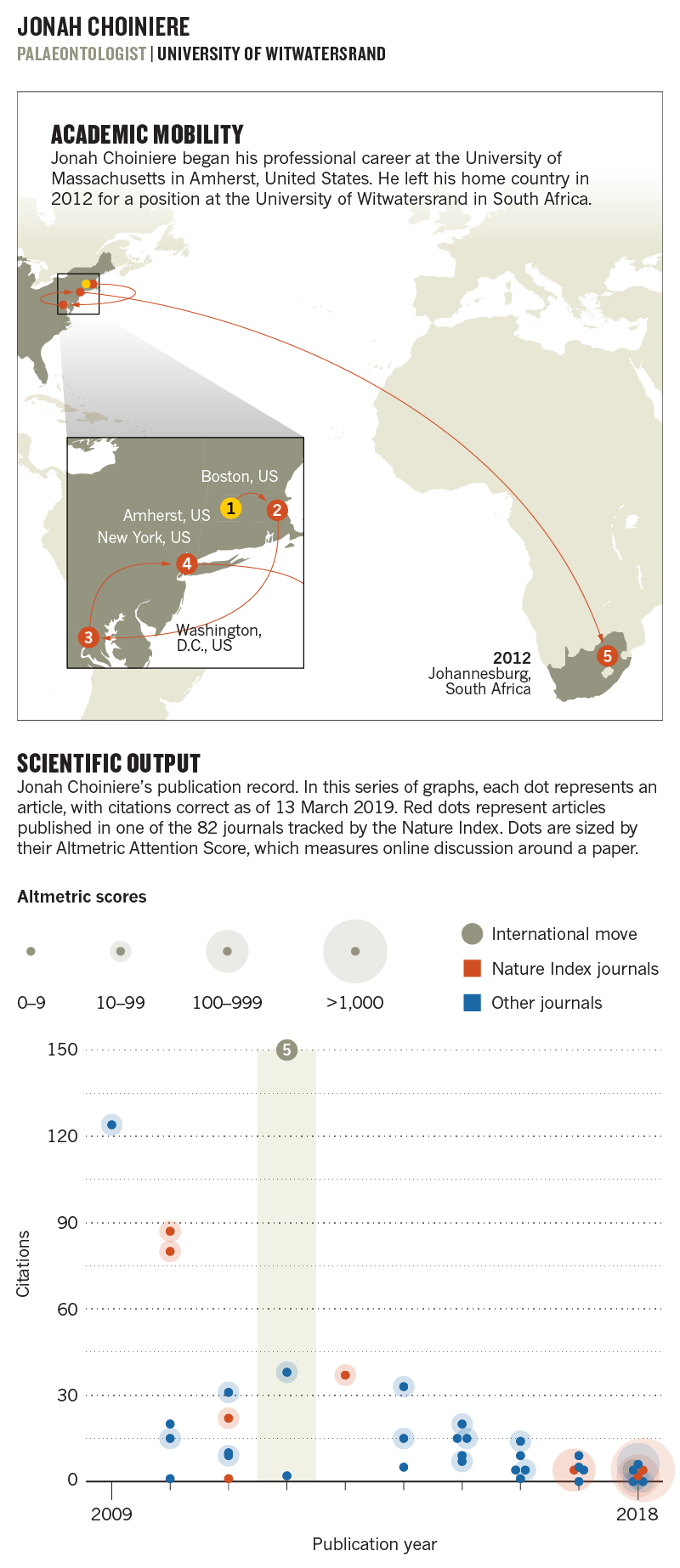
Source: Nature Index/Dimensions from Digital Science
The research has also been rewarding. Since arriving, Choiniere has named seven new species, including a hulking, lumbering, four-legged herbivore named Ledumahadi mafube, which means ‘giant thunderclap at dawn’ in the Southern Sotho language. Living some 200 million years ago, L. mafube is the largest animal known to have roamed the land at the time.
But Choiniere’s students at Witwatersrand do not enjoy the same level of mobility as he did. “The cost barrier is prohibitive.” To put it into perspective, he says, a 10-day overseas research trip costs more than a local student’s entire year of postgraduate tuition. Students from the US, UK or Europe have larger support packages and access to travel grants. “They can come here and develop projects on specimens that we have laid the groundwork for, but our students don’t have the ability to reciprocate,” says Choiniere. “There is a tremendous trade deficit.”
“Large countries that drive research need to take a critical look at whether, in fact, they are scientifically colonising places like Africa,” says Choiniere. They could, for example, allocate funds in collaborative grants for students from abroad to visit their facilities, he adds.
China offers a replicable model. “They have bargained much harder to have Chinese authors play leading roles in publications and get Chinese students placed in top international research organisations,” says Choiniere.
In 2015, he received a grant from South Africa’s National Research Foundation, which enabled a straight swap of two researchers and two students for training and fieldwork with the Institute of Vertebrate Paleontology and Paleoanthropology, Chinese Academy of Sciences.
Together, the research teams analysed skeletons from two dinosaurs discovered in the crimson outcrops of Wucaiwan, in China’s north-western Xinjiang, and the weathered rocks of north-eastern Inner Mongolia. They found that the small two-legged Alvarezsaurian raptors evolved super-strong, clawed hands, which they probably used to dig for ants the way today’s aardvarks do.
Achieving a balanced partnership takes active management, says the palaeontologist.
PETRA KRAUS: Hello, goodbye Singapore
Migrant
A German stem-cell scientist trains the next generation of researchers in the island nation.

Thomas Lufkin
It was clear from the start that Singapore wouldn’t be a permanent move. In 2003, Petra Kraus quit her job at a biotech company in Tarrytown, New York, to join the Genome Institute of Singapore (GIS), part of the country’s network of public research labs, Agency for Science, Technology and Research (ASTAR). “We were told that our time would be limited,” says the biologist. “Our job was to educate the growing local population of young scientists, and develop their basic research skills to the point where Singapore could become a profitable biotech centre.” Three, three-year contracts later, she says, “we no longer fit in the picture.” ASTAR, she says, had begun the next phase of translating basic science into commercial products.
Kraus, who has returned to the US east coast, where she teaches molecular biotechnology at Clarkson University, speaks fondly of her time on the island. Having mostly worked with mouse embryonic stem cells before moving to Singapore, the move gave her access to human embryonic stem cells and induced pluripotent stem cell culture, top-notch animal facilities, next-generation sequencing technologies, and more funding. At GIS, her team primarily studied the transcriptome of developing axial skeletons.
“I have learned so much from moving to different places,” she says, picking up little “tricks and twists” that make work more efficient.
Her family also benefited from the high-quality childcare, international schools and affordable domestic help in Singapore.
Reconnecting

Source: Nature Index/Dimensions from Digital Science
Kraus started her research career at Ulm University, in a medieval city in southern Germany. A summer course at The Jackson Laboratory in Bar Harbour, Maine, piqued her appetite for travel. “A lot of highly respected scientists in our field came from the US,” she says. Many researchers in her department at Ulm made trips abroad, but mostly of short duration. After completing her PhD, Kraus left for the US and did not look back.
She first worked as a postdoctoral researcher at New York University School of Medicine, before joining Regeneron Pharmaceuticals in Tarrytown.
Her return to North America in 2013 was more trying. Every relocation has meant losing contact with long-cultivated local networks, she says. “Being out of the loop can have an impact when searching for jobs and applying for grants.”
In particular, she had to find her way around changes to the US National Institutes of Health’s grant application system. Fifteen years ago, Kraus remembers rushing to the FedEx office to post her documents. Now everything is done online. Requirements and layouts have changed, she says. “Any little mistake can mean the end of an application.”
But she has gradually settled into her niche: stem cell therapy for the intervertebral disc, the cushioning that forms between units of backbone, which acts as a natural shock absorber. With age, this tissue gradually degenerates, which can result in severe neck and back pain. Many clinical trials are exploring the potential of treating the condition with stem cell injections.
Kraus’s work involves determining the complex population of cells that make up the intervertebral disc, for more targeted therapies. “To come up with a regenerative medicine approach, we need to know what cell type we are dealing with,” she says. Her team has found that the disc consists of many different types of cells, some of which behave a lot like stem cells. They have also found that mice offer poor models of the cell mix found in mature human discs.
TOM GLEESON: Groundwater mapper
Not internationally mobile
A Canadian hydrogeologist makes his mark close to home.
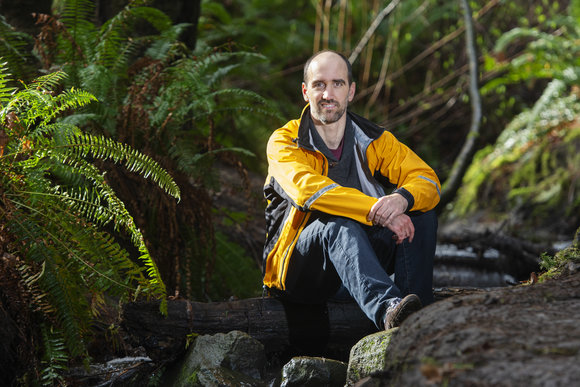
University of Victoria
Tom Gleeson is exactly where he wants to be. A canopy of spruce and pine is background to his backyard vegetable garden and chicken coup in the small Canadian city of Victoria. The beach is a just a stroll away. And a 20-minute cycle will take him to his office at the University of Victoria. He often meets a deer on the way.
“Having access to nature is just as important to me as a stimulating intellectual environment,” says the hydrogeologist and engineer. “Where I live keeps me a happy and productive researcher and teacher.”
Gleeson has spent his entire career in Canada, shuttling between the east and west coasts. “Canada is home,” he says, but there are other reasons for staying. The country’s science funding strategy supports long-term, fundamental discovery. Gleeson, for example, has received a five-year grant from the Natural Sciences and Engineering Research Council of Canada, which supports fundamental research with no strings attached, allowing him to jump on new ideas quickly.
In 2011, while working as a postdoctoral fellow at The University of British Columbia, he published the first global permeability map, which showed how fluid permeates up to five kilometres of the Earth’s surface soil and rock. The map informed a much larger assessment that Gleeson later initiated while at McGill University in Montreal. Extending the concepts of the ecological and water footprints, he developed a global groundwater footprint, to measure the area required for aquifers to sustain the world’s groundwater use and groundwater-dependent ecosystem services.
The paper, published in Nature in 2012, estimated that the current aquifer capacity has been exceeded by about 3.5 times, with 1.7 billion people living in regions where groundwater resources and the ecosystems that depend on them are under threat.
Giving back

Source: Nature Index/Dimensions from Digital Science
Gleeson’s deep roots in the province of British Columbia also ensure that his research, which is global in outlook, has local impact. The field of hydrology, he says, recognizes the importance of being “grounded in a place” and having an intricate “knowledge of a region’s idiosyncrasies.”
He has collaborated with water scientists at British Columbia’s Ministry of Environment & Climate Change to answer high-priority questions, such as how pumping groundwater affects river flow. He has also developed a tool for determining aquifer stress across the province, for water managers to use in making decisions about licenses. “I am always trying to navigate the interface between scientific research and its relevance for policy and sustainable water management,” he says.
While Gleeson has not felt the pressure to move abroad, he does need to stay plugged into an international network. He spends his mornings chatting with collaborators in Europe over Skype, and sends daily emails to colleagues based in several countries. For closer contact, Gleeson often goes on short trips overseas, which he finds can be more productive than longer stays. “It is like the Pareto principle,” he says. “You get 80% of the impact with 20% the effort.”
In a year, Gleeson could go on three international trips of up to two weeks, and host several international visitors, in addition to attending conferences and meetings. “I have put a lot of attention and effort into nurturing and maintaining these relationships.”
Most recently, Gleeson partnered with researchers in the UK, Australia, Germany, France and the US to study the sensitivity of groundwater systems to climate change. They found that water-scarce regions are largely resilient to fluctuations in climate. More humid areas, however, representing a quarter of the Earth’s surface, respond to changes in climate at timescales of 100 years or less, with a few especially sensitive pockets in, for example, the Amazon and Congo basins.
“I am lucky,” says Gleeson. “I get to live exactly where I want to live, doing exactly what I want to do. That is not true for everybody.”
MARINA ELLIOTT: Creeper and crawler
Migrant
A Canadian scientist goes spelunking for ancient hominin remains in South Africa.

Marina Elliott and the University of the Witwatersrand
Marina Elliott’s arms and legs are scratched and bruised. For the past week, the biological anthropologist’s commute to work has involved creeping, crawling and climbing through 200 metres of underground passages and caverns, in a cave system north of Johannesburg, South Africa.
The half-hour journey, which includes squeezing through an 18-centimeter wide opening, takes her to a dark, cool and humid chamber, where she spends her day studying hominin fossils, occasionally visited by bats, porcupines and snakes.
“It is quite a pleasant environment to work in if you are unusual like us,” says Elliott, a researcher at the University of Witwatersrand, and one of the six so-called Underground Astronauts, recruited in 2013 by palaeoanthropologist, Lee Berger, via Facebook, to excavate the site. The dig turned up 1,550 bone fragments from some 15 individuals of a previously undescribed hominin species, Homo naledi.
Elliott moved almost halfway around the world, from Vancouver, Canada, to join the team.
The decision wasn’t an easy one. While Elliott had travelled a lot as part of her PhD coursework, from Lake Baikal in Siberia to Utqiagvik in Alaska, South Africa was her first permanent relocation. Her family worried about her safety — “both underground and on the surface” — and being paid in rand has meant that visits home are expensive and infrequent. She often also misses out on conferences, many of which are held in North America.
But for Elliott, the move has been both professionally fulfilling, and the right thing to do. “It was important for me to come here, to where the fossils are,” says Elliott. “The old model of researchers going to a country, digging and taking the materials back to North America or Europe doesn’t work anymore.”
Her proximity to the site means that she can schedule excavations throughout the year, instead of waiting for the summer holidays.
Keeping materials in the country of origin also benefits local communities and researchers, she says. It shows “students that their backyard has research potential,” and “brings money, political influence and prestige to the home country”.
Curved fingers

Source: Nature Index/Dimensions from Digital Science
Soon after the first excavation, Elliott's team invited more than 50 researchers from all over the world to Johannesburg to assess the treasures. “Collectively, we must have put in 10,000 to 12,000 research hours into those six weeks.” They published their first papers on the new species in 2015, and in 2017 reported on the age of the fossils. Their estimates suggest that H. naledi, a slight hominin with long, curved fingers and a small skull, lived surprisingly recently, between 200,000 and 300,000 years ago, around the time that modern humans started evolving. The chamber in which they were found was probably a site for disposing bodies.
Sieving through the sediment, Elliott and her Witwatersrand colleagues also uncovered three tiny ear bones, shaped like those in chimpanzees but sized to human proportions.
The entire collection has forced researchers to “rethink what we thought we knew about human evolution,” she says.
The global buzz it generated also caught the attention of a local student, who emailed the team asking if she could contribute somehow. Berger offered her a position as a caver. In August 2016, she was sponsored by a private foundation to pursue a master’s in palaeoanthropology at Georgia Southern University in the US, and will start her PhD at Texas A&M University in August 2019. “When she finishes, we hope she will come back to Africa to work with us,” says Elliott.
Elliott is aware of the legacy of colonization in science, and tries to give back. Her group has hired several local fossil preparers and have had South African graduate students join recent excavations. The team relies on locals for camp management and logistical support, and Elliott spends a lot of her spare time informing the general public about their work. “Science is not something that only university researchers do,” she says. “We need to be part of the community.”
JULIEN GIRARD: Exoplanet hunter
Migrant
An astronomer studies distant planets and stars from many viewpoints.
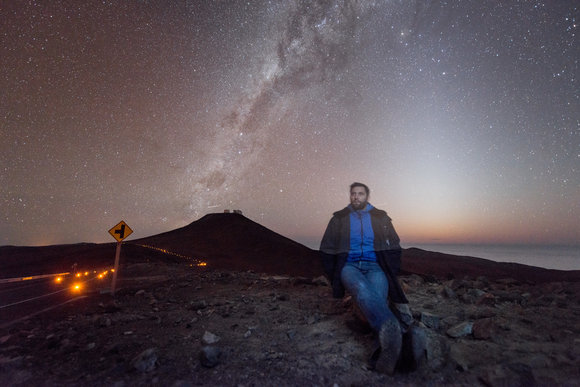
© Henning Avenhaus (Paranal Observatory, September 2015)
Julien Girard is an itinerant scientist, if ever there was one. The Frenchman has lived in three continents, four countries, and more than seven cities, with competence in six languages to match.
His displacement is partly a function of his field. Earth-based observatories are stationed in remote locations such as on Mauna Kea volcano in Hawaii and the Canary archipelago, with a few space missions controlled primarily out of the US, Europe and Japan. Projects have become larger and more expensive, requiring highly specialized skills that can often only be found far from site. Astronomy also suffers from the bottleneck, common in science, of a growing population of graduates competing for limited academic positions.
“Nowadays in astronomy, it is almost easier to find a job on the other side of the planet than in your own country,” says Girard, who currently works for the Space Telescope Science Institute in Baltimore, US, where he engineers spacecraft that search the skies for exoplanets.
“Stability is a recurrent topic of conversation among young astronomers.” Many find it difficult to maintain a family, he says, with some even abandoning the field to go into teaching or to apply their skills, such as in data science or optics, in the private sector.
But Girard has been fortunate. Married with two children, he has travelled with his family from Mexico (where he met his wife) to Chile, and the US, as well as for annual visits home to France. Every change in residence has come with the chance to reinvent himself professionally.
Planet hunting
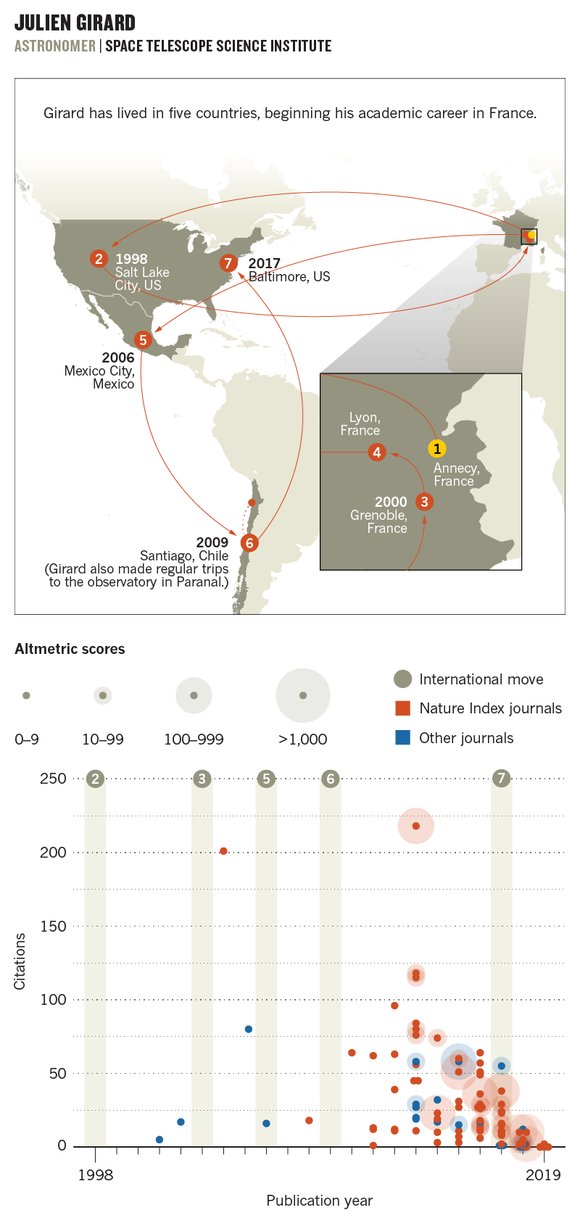
Source: Nature Index/Dimensions from Digital Science
Girard grew up in two small towns close to the Swiss–French border. After completing his undergraduate degree in physics, he moved to the University of Utah to attain a master’s in instrumentation physics, while also working on an experiment to detect ultra-high-energy cosmic rays, which are extra-terrestrial particles constantly showering Earth. He returned to France for a second master’s in astrophysics in Grenoble and a doctoral thesis in Lyon, quantifying the effect of atmospheric turbulence on large ground telescopes and building a prototype for a certain type of adaptive optics involving lasers.
In 2006, Girard packed up for Mexico, initially developing an adaptive optical system as a post-doctoral researcher at the Institute of Astronomy, National Autonomous University of Mexico, and later as an assistant professor at the National Polytechnic Institute. He started to shift focus to observational science, using the optical systems he had developed to look for companions of brown dwarfs, which are not quite stars and not quite planets either.
In 2009 Girard accepted a position as a staff astronomer at the European Southern Observatory in Santiago, Chile. At least once a month, he travelled by taxi, plane and bus, 1,200 kilometres north through the Atacama Desert to the observatory at Paranal, where he would spend more than a week on nightshift. He made more than 100 such trips, spending close to 1,000 nights under the desert sky.
His work led to the clearest observations of the cold dust orbiting a young star named AU Microscopii, some 32 light-years from Earth and aged in its early twenties (of millions of years). This disc of debris represents the earliest stages of planet formation.
Eight years of splitting his time between family and night-sky wore Girard down. But by then, he was approaching 40 and had missed the window of opportunity for a permanent position in Europe.
In 2017, he moved to Baltimore, to join a space mission building a NASA flagship telescope. Set to launch in 2021, the telescope will hunt for exoplanets and answers to fundamental questions about dark energy. “I prefer to be a bit less selfish and contribute to answering big questions as a team member rather than doing my own, somewhat less impactful projects,” says Girard. The ultimate goal, he says, is to find a planet like Earth with extra-terrestrial life.
This article is part of the Nature Index 360° series, which takes an all-round look at key topics in scientific research performance and publishing.
Related content: Five scientists explain how they decided whether to move to another country for their work or studies
